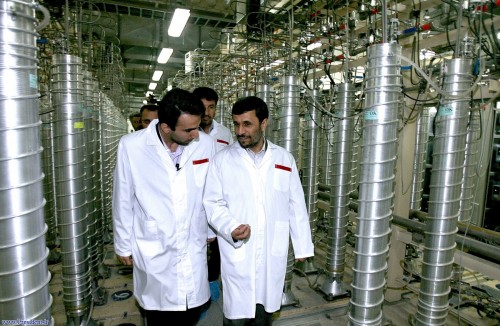January 03-2014

The first argument over the interim nuclear agreement has erupted with Iran saying it has installed a new centrifuge design for testing and the Big Six saying that is forbidden under the agreement.
The Associated Press reported from Vienna that Iranian officials in the ongoing technical talks have told the Big Six that “some” new-design centrifuges have been installed in the testing section at Natanz. No number was given.
But the AP said the other delegations—apparently all six of them—objected that this violated the interim agreement, which bars any increase in the number of installed centrifuges and any installation of new and more advanced model.
The Iranian delegation reportedly argued that the installation was allowed under the provision of the interim agreement that permits centrifuge research to continue.
That conflict has still not been resolved as of this writing and may have to be taken to the level of the foreign ministers.
Ali-Akbar Salehi, the head of Iran’s Atomic Energy Organization, said last Thursday that Iran is developing a whole new generation of centrifuges and getting it ready for mass production. He said nothing about installing any at Natanz, but he implied that had happened since he spoke of testing the centrifuges.
That announcement infuriated some in the US Senate, who used the announcement as an argument for passing new sanctions into law right away while talks continue with Iran.
Democratic Senator Bob Menendez of New Jersey, the chairman of the Senate Foreign Relations Committee and the main person behind the new sanctions bill drafted last week, told Fox News the “Iranians are showing their true intentions” with the new centrifuge announcement. But he failed to pick up on the issue of whether testing the new design violated the agreement,
Instead, he argued, “If you’re talking about producing more advanced centrifuges that are only used to enrich uranium at a quicker rate,… [then] you’re really not thinking about nuclear power for domestic energy. You’re thinking about nuclear power for nuclear weapons.”
Not everyone agreed with Menendez’s logic that faster centrifuges could only be linked to weaponry, however.
The interim nuclear agreement signed November 24 allows Iran to continue testing and working on the half-dozen centrifuge designs it has been trying to perfect in recent years. But it doesn’t allow Iran to install even a single newer variety of centrifuge. It is allowed to enrich only with its original IR-1 design and it can install further IR-1s only to replace IR-1s that are currently enriching but break down. In other words, Iran can continue enriching with the same number of the same design of centrifuge as now, but may not expand the number of centrifuges or replacing existing ones with newer models.
All Salehi said was that “a new generation of centrifuges is being developed, but they should undergo all tests before mass production.”
He did not say mass production would begin while the interim agreement is in force. But he also did not bother to note that mass production cannot begin while the interim agreement is in force.
To many it appeared Salehi was just joining in the regime effort to sound tough and make it appear to the public that the Islamic Republic conceded nothing to the Big Six in signing the interim agreement.
The real question is whether the interim agreement’s ban on installing new centrifuges encompasses just the production halls at Natanz and Fordo or also covers the room where centrifuges are set up in cascades to test them. The agreement is not clear on that point.
The latest Senate sanctions bill was introduced in December with 26 of the 100 senators sponsoring it. It now has a total of 47 sponsors, which makes passage appear very likely if it is brought up for a vote. President Obama has said he will veto the bill. The supporters say they are seeking to line up 67 sponsors, two-thirds of the Senate membership and enough to override a veto.
